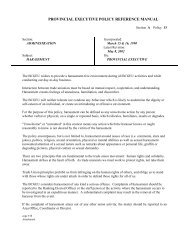JUSTICE DENIED - BC Civil Liberties Association
JUSTICE DENIED - BC Civil Liberties Association
JUSTICE DENIED - BC Civil Liberties Association
- No tags were found...
You also want an ePaper? Increase the reach of your titles
YUMPU automatically turns print PDFs into web optimized ePapers that Google loves.
ccla<strong>BC</strong> <strong>Civil</strong> <strong>Liberties</strong> <strong>Association</strong><strong>JUSTICE</strong> <strong>DENIED</strong>The Causes of <strong>BC</strong>’s Criminal Justice System Crisisbccla.org1
<strong>JUSTICE</strong> <strong>DENIED</strong>The Causes of B.C.’s Criminal Justice System CrisisAuthor: Kevin TilleyEditor: David EbyIMPORTANT NOTICEThe material in this report has been prepared and published for educational anddiscussion purposes only. It is not legal advice and it is not intended that the information inthis report should in any way replace legal advice from a qualified lawyer. Individuals withspecific legal problems should seek advice from a qualified lawyer.© B.C. <strong>Civil</strong> <strong>Liberties</strong> <strong>Association</strong>, 2012Contents may not be commercially reproduced, but any other reproduction isencouraged. Where reproduced, attribution should be given to the B.C. <strong>Civil</strong><strong>Liberties</strong> <strong>Association</strong>.Funding provided by the Law Foundation of B.C. and the <strong>BC</strong>GEU.The Law Foundation of British Columbia1340 – 605 Robson StreetVancouver, B.C., V6B 5J3www.lawfoundationbc.org<strong>BC</strong>GEU4911 Canada Way,Burnaby, B.C. V5G 3W3www.bcgeu.caTo order copies of this report, please contact:B.C. <strong>Civil</strong> <strong>Liberties</strong> <strong>Association</strong>550-1188 West Georgia StreetVancouver, <strong>BC</strong>, V6E 4A2Tel: 604.630.9757e-mail: info@bccla.orgwww.bccla.orgCataloguing data available from Library and Archives Canada.
<strong>JUSTICE</strong> <strong>DENIED</strong>The Causes of B.C.’s Criminal Justice System CrisisKevin TilleyEdited by David Eby
CONTENTSExecutive Summary 5Introduction 9The Big Picture: A Decade of Under-Funding 11Stage 1: Bail and Intake 15Stage 2: Court Proceedings 21Stage 3: Sentencing and Custody 27Moving Forward – The Green Paper 33
EXECUTIVE SUMMARYThe criminal justice system in B.C. is in crisis.The court system has slowed to crawl, asshortages of staff and judges have causedcourtroom closures and an unmanageablebacklog of criminal cases. The waiting timefor trial has reached a level where hundredsof cases are at risk of being dismissed for delay.Meanwhile, our prisons are dangerouslyovercrowded, leading to rehabilitative effortsfailing and increasing injuries among staff.These problems are not a surprise. Since 2001,the budget for court services including administrativestaff and security has been cut 42%. Thebudget for corrections has been cut 29% in thatsame time period and the funding for legal aidhas been cut 36%. Despite a significant overalldecrease in crime in our society, in 2008 B.C.’sjustice system had 14.8% more cases than it did in2001, and our jails housed 16% more prisoners.WHAT’S WORKINGCrown charge review saves reputations,and creates efficiencies that otherprovinces are not experiencingIn some cases, B.C. has done a good job oftargeting spending in places that result in significantnet savings. For example, in B.C., as inNew Brunswick and Quebec, Crown prosecutorsscreen cases before charges are laid in courtwhereas the rest of Canada sees charges laidby the actions of the police alone. Vetting byCrown removes frivolous or weak cases at thefront end rather than wasting court resourcesonly to have those cases collapse at a later stage.In Quebec, New Brunswick and B.C., whereCrown screening of charges is policy, only 17%of cases are stayed or withdrawn as compared to36% for the remaining provinces. Additionally,those three provinces succeed in securing a findingof guilt in 73% of cases as compared to 62%for the rest of Canada. Policies like these thattarget spending on services that make the systemwork more efficiently, and protect rights, shouldbe encouraged in other parts of the system.If one assumes that without pre-chargescreening B.C. would match statistics inprovinces that do not use Crown screening,B.C. would have approximately 7,000 additionalcases in the criminal justice systemper year, adding tens of millions of dollarsto the overall cost of operating the system.Our justice system is working harder,and doing more, with significantly lessWhile recent provincial government press releaseshave decried a crime rate reduction andapparent increases in costs, our court systemis handling more cases with fewer resourcesthan ever before. During the period 2001 to2009, highlighted by dramatic provincial spendingcuts of between 30% and 45% to variousdepartments and services in the criminaljustice system, the number of cases has notdeclined. In 2001 B.C.’s criminal justice systemhandled 40,510 cases. In 2008/2009, themost recent year for which data are availablefrom Statistics Canada, B.C.’s justice systemhandled 46,472 cases, an increase of 14.8%.In the period between March 31, 2008 and January21, 2012, the number of full-time equivalentprovincial court judges dropped from 141.9 to121.35. Even after nine new judges were recentlyappointed, there is still an 8.1% decreasefrom 2008, and the system is 9% short of whatthe Court has told the province it needs tokeep pace with the new cases arriving each day.5
WHAT’S NOT WORKINGPeople with mental health issues are using toomany police, court and jail resources, insteadof more efficient and humane healthcareresourcesToo many people with mental illness are beingbrought before the courts at significantcost. The Vancouver police estimate that 31%of their calls involve persons in poor mentalhealth. Approximately 29% of inmates inprovincial jails are mentally disordered. Currentlymental health treatment is not availableat the levels required, meaning that toomany people in need of health care end upin an already over-burdened court system.More people are in jails waiting for trials thanare in jail serving a sentenceProvincial jails are overcrowded due to fundingcutbacks and an increase in the numberof people being held in remand. Remand facilitieshouse people deemed inappropriatefor bail while they wait for trial. There arenow more people in provincial jails awaitingtrial than there are serving a prison sentence.Fifty-nine percent of all adult and 55% of allyouth inmates in B.C. prisons are waiting fora trial. The cost of housing adult remand inmatesalone is likely in the range of $30 millionper year. Much of that money would be betterspent on improving bail supervision programsto offer alternatives to custody for those awaitingtrial, or improving courthouse resourcesto speed up trials and reduce pre-trial custody.Self represented defendants clogging up thecourt systemFunding for legal aid is now 36% less than itwas in 2001, resulting in a significant numberof people before the courts without a lawyer.Unrepresented accused cause excessive delaysand draw resources from court administrators,judges, Crowns and others who find themselvesgiving assistance in navigating complicated legalprocesses. In 1999/2000, 27,479 people receivedlegal aid for criminal charges. By 2010/2011,that number had dropped 26% to 20,224, withwell over 7,000 more criminally charged individualsappearing before courts without lawyers.Delays before trial are up 28% in just six yearsThe delays in setting trial days have reachedcrisis levels. The average time between chargeand trial has gone up 28% since 2005 andthe backlog has become unmanageable. Fortypercent of cases have been in the systemfor over 10 months and are at significantrisk of being dismissed for undue delay.B.C.’s prisons have ratios of up to 60 inmatesfor one staff member, putting both groups atsignificant riskB.C.’s prisons are massively overcrowded withsome institutions operating at twice their intendedcapacity. The ratio of inmates to officershas increased from 20:1 in 2001 up to 60:1 insome institutions, putting the health and safetyof corrections officers at risk. Studies showthat over 87% of corrections officers havebeen hit by blood, 77% had been threatenedby inmates and 36% had been assaulted on thejob. 17% of officers had witnessed a homicideor suicide of an inmate within the past year.Overcrowding presents major concerns forprisoner safety. From 2004-2011, 51% ofdeaths in provincial facilities were due to unnaturalcircumstances including homicide,suicide, and accidental overdose. More hasto be done to ensure that jail sentences donot unintentionally become death sentences.Prison overcrowding also presents difficultiesin delivering rehabilitative programmingfor inmates. Studies suggest that going to jailincreases the risk of homelessness by 40%,raising concerns about the broader social6
costs of a prison system that is unable to providesupport and programming on release.Only 35% of community programming foroffenders is fulfilled due to high caseloadsfor probation officersCutbacks to corrections have lead to a risein the workload faced by probation officers.B.C.’s probation officers now have the secondhighestcaseload in Canada. That caseload hasmeant less time to deliver programming suchas violence intervention and substance abusecourses. Presently, only 35% of such programmingis ever completed, raising concernsabout the effectiveness of B.C.’s rehabilitationsystem and the likelihood of re-offending.WHAT WE SHOULD DOB.C.’s justice review must emphasize fairness,justice, due process, and public safety, andaffirm the justice system as an essentialservice that requires fully funded resourcesto fulfill its roleThe <strong>BC</strong>CLA welcomes the announcement ofa government-led review into the justice systembut cautions that such a review shouldaim to protect fundamental freedoms and recognizethe importance of the justice system inour democracy. Invariably, adequate resourcesare required to achieve this. However, the invocationof a business administration modelto reforming the justice system is inappropriate.An efficiency in business may save moneyand increase profit. But just as Supreme Courtof Canada Justice Laforest noted in the contextof fiduciary obligations generally, “the lawhas recognized the importance of instilling inour social institutions and enterprises somerecognition that not all relationships are characterizedby a dynamic of mutual autonomy,and that the marketplace cannot always set therules.” A single-minded focus on efficiency inthe justice system will lead to the violation ofrights, put the public at risk, and jeopardize theconstitutional right to a fair trial. The justicesystem is something that is administered bygovernment as a public trust. Business systemsand justice systems are simply not the same.Nonetheless, the justice system in B.C. is presentlyin a government-induced crisis and the needfor reform is pressing. The current problemswill not be fixed through simple improvementsin efficiency, the integration of management,or by tampering with judicial independence. Instead,what is needed is a real commitment tojustice through adequate funding as well as strategicreforms that prevent crime and recidivism.7
INTRODUCTIONThe Canadian criminal justice system is a complexmachine, requiring the participation andcooperation of a vast array of actors includingthe provincial government, the judiciary, the legalbar and the staff who administer its operations.In B.C., that machine is showing signs ofmalfunction. Recent reports have highlightedproblems of delay in completing criminal cases.High profile criminal cases have been dismissedfor undue delay, courtrooms regularly face unmanageablebacklogs and staff shortages areimpeding the smooth functioning of the system.The Chief Justice of the Supreme Courtof B.C. has declared in a recent speech beforethe Canadian Bar <strong>Association</strong> that the justicesystem in B.C. “is threatened, if not in peril”. 1The threat posed by a breakdown of the justicesystem cannot be overstated. The administrationof criminal justice not only delivers aservice to the people of the province but alsoconstitutes a fundamental tenet of our democraticorder. The people of B.C. expect a justicesystem that can deliver justice in a manner thatis fair, accountable, and timely. As confidence inthe administration of criminal justice is eroded,the viability of the rule of law and the properfunctioning of our social order is put at risk.A poorly functioning justice system allowscrimes to go unpunished, alienating victims andtheir families, compromising the confidence ofthe public and heightening the risk of vigilantism.Accused individuals who find themselvesinvolved in a dysfunctional system are at increasedrisk of miscarriages of justice and thearbitrary loss of liberty. Inadequate resourcesfor correctional centres leads to inhumane conditions,dangers to staff and prisoners alike,and failed rehabilitative services, increasing therisk of recidivism. Our society and the well-beingand liberty of all citizens requires that ourcriminal justice system be effective and just.The purpose of this reportIn B.C., many commentators have proclaimedthat our courts have reached apoint where a breakdown of this fundamentalsocietal institution is imminent.A large portion of the blame for the current stateof affairs is laid at the feet of the provincial governmentfor failing to provide adequate fundingin the places where it is needed most. This paperexamines whether such blame is appropriatelyassigned to the provincial goverment, orwhether, as the provincial government suggests,our justice system has failed to find necessaryefficiencies given declining crime rates and concomitantreduced burdens on the justice system.In preparing this report, we conducted interviewswith key individuals involved in the administrationof justice in B.C. including probationofficers, court clerks, corrections officersand sheriffs. We also conducted secondary research,collecting and analyzing reports preparedby various groups: Stats Canada, the1 “Challenges To The Budget For The Court Services Branch”, Remarks of Chief Justice Bauman,at the Canadian Bar <strong>Association</strong> B.C. Branch Meeting, 19 November 2011, Las Vegas, Nevada.9
judiciary, lawyers, provincial and federal governmentsand non-governmental organizations.We have presented our findings in a reportform that examines the stages of the criminaljustice system chronologically as they wouldbe experienced by an individual charged witha criminal offence, beginning with the decisionby the police to arrest and recommend a charge,Crown Counsel review of that charge, remandfacilities where people await their trials, and thetrial process. Finally, the report considers thestate of correctional resources including bothcommunity correctional efforts and prisons.10
THE BIG PICTURE: A DECADE OF UNDER-FUNDINGOur findings are not reassuring. Throughout,the research points out that the vast majorityof the challenges faced by the system todayare the direct result of policy decisions andfunding shortfalls made over the past decade.In 2002, the provincial government began aprogram of across-the-board cutbacks to governmentservices in B.C. Chief among targeteddepartments and systems was the justicesystem. That year, the government closed 24courthouses across the province, reallocatingthe caseload from those locations to other judicialcentres or re-designating certain locationsas circuit courts where justice would be deliveredperiodically by visiting judges and staff. 2In tandem with cuts to the administration ofjustice, the provincial government also institutedcuts to correctional centres. Beginning in2002, ten correctional centres in the provincewere closed, leading to the increasing centralizationof inmate populations and the downsizingof staffing levels at correctional centres. 3Also in 2002, the government put in placecutbacks to funding for legal aid and associatedcommunity legal support programs. In1999/2000, 27,479 people received legal aidfor criminal charges. By 2010/2011, that numberhad dropped 26% to 20,224, with wellover 7,000 more criminally charged individualsappearing before courts without a lawyer. 4From 2001 to 2012, the budget for correctionshas been cut by a total of 29%. The budget forcourt services, including both administrativestaff as well as security, has been reduced by42%. The budget for justice services, which includesthe grant for legal aid, has been reducedby 26%. 5 The graphs on the following pagesillustrate the changes in budgets since 2001.Recently, the Ministry of Finance issued a reportdated February 8, 2012 accompanied by aGreen Paper directed at eventual policy reforms. 6Those documents point at rising costs with concernand suggest improvements that could bemade towards increased efficiency. While efficiencyis a laudable goal, the justice system is alreadyhandling 14.8% more cases with 30-40%fewer resources, and is on the verge of collapse.As the past decade of budget cuts have vividlydemonstrated, cost-cutting measures can haveradical and far-reaching effects on the systemfor many years to come, including on mentalhealth, homelessness, justice and public safety.2 Provincial Court of B.C., Annual Reports, available online: www.provincialcourt.bc.ca(viewed February 2012).3 Patricia Fisher, “<strong>BC</strong> Corrections - Adult Custody Division: Highlights of 2007 Organizational HealthAssessment Report & Recommendations”, Ministry of Public Safety and Solicitor General (2008).4 Annual Report 2000/2001 and Annual Report 2010/11, Legal Services Society of B.C. (2001),www.lss.bc.ca/about/annualReports.php (viewed February 2012).5 All figures based on budget documents between the fiscal years 2001/2002 to 2011/2012, www.bcbudget.gov.bc.ca (viewed February 2012). All figures have been adjusted for inflation to 2012 dollars.6 “Review of the Provincial Justice System in B.C.” (2012). Available at: www.ag.gov.bc.ca/public/JusticeSystemReview.pdf (viewed February 2012).11
$120million100Legal Services Society Budget 2001 - 20108060402002001 02 03 04 05 06 07 08 09 10Years$200millionCourt Services Budget 2001 - 20121501005002001 02 03 04 05 06 07 08 09 10 11 12Years12
$300million250Corrections Budget 2001 - 20122001501005002001 02 03 04 05 06 07 08 09 10 11 12Years$150million120Justice Services Budget 2001 - 201290603002001 02 03 04 05 06 07 08 09 10 11 12Years13
STAGE 1: BAIL AND INTAKEPre-Charge ScreeningIn Canada, the criminal process most often beginswith a decision by the police to initiate proceedings.B.C. is among a minority of provincesin requiring Crown prosecutors to screen casesbefore formal charges are laid before the court.Through this process, a lawyer for the Crownreviews the police investigation to determinewhether there is a reasonable prospect of convictionand whether the public interest wouldbe served by the case proceeding to court.As the Ministry of Finance recently noted, theprocess of pre-charge screening is largely responsiblefor the fact that the costs of prosecutinga case in B.C. are significantly higherthan other provinces. 7 However, there are someindications that these initially higher costs areoffset by savings further down the line. Statisticssuggest that pre-charge screening has theeffect of reducing the number of frivolous orunnecessary cases before the courts. The threeprovinces that employ a form of pre-chargescreening (B.C., Quebec and New Brunswick)enjoy a significantly lower proportion of casesthat are ultimately stayed or withdrawn (at 17%)as compared to the remaining provinces (at36%). 8 This means that, in provinces withoutcharge screening, an average of 19% of casesare unnecessarily draining resources before ultimatelybeing thrown out. Charge screeningcould have eliminated those cases at the outset.Additionally, a higher portion of cases in provinceswith pre-charge screening result in a findingof guilt (at 73%) as compared to the restof Canada (at 62%). Accordingly, almost onein ten cases in jurisdictions without Crownscreening go all the way through the criminaljustice system, consuming resources, includingfull trial, without any meaningful outcome.The increased conviction rate in Crown screeningjurisdictions is likely due to significantCrown-police consultations before a charge islaid that allows additional investigative stepsto be taken by police to satisfy legal tests andincrease the likelihood of conviction at trial.Although further research is required to draw definitiveconclusions, if one assumes that withoutpre-charge screening B.C. would match the stay/withdrawal and “not guilty” statistics in provinceswithout pre-charge screening, B.C. wouldhave approximately 7,000 additional cases in thecriminal justice system per year. Other reportshave put that number as high at 40,000 new cases.9 Those additional cases would add millionsof dollars to the cost of operating the system.Beyond financial considerations, it is also importantto note the personal hardship enduredby individuals and their families upon beingcharged with a criminal offence when the casescollapses before a trial or guilty plea. The7 Ibid.8 Statistics Canada Summary Tables “Cases in adult criminal court, by province and territory”www40.statcan.ca/l01/cst01/ (viewed February 2012).9 “Don’t Let Police Lay Charges: Justice Branch”, Canada.com, www2.canada.com/cowichanvalleycitizen/news/story.html?id=5d5ee4ea-e4fc-479c-9afd-00978632c55b(viewed March 2012).15
Pre-Charge ScreeningCases Guilty % Stay %<strong>BC</strong> 40,467 28,681 70.88 10,681 26.39Alberta 53,375 34,215 64.10 17,411 32.62Saskatchewan 21,665 14,506 66.96 6,815 31.46Manitoba 16,849 10,793 64.06 5,963 35.39Ontario 137,902 81,971 59.44 53,242 38.61Quebec 54,498 40,079 73.54 5,014 9.20New Brunswick 7,664 6,082 79.36 1,297 16.92Nova Scotia 11,760 7,583 64.48 3,876 32.96Prince Edward Island 1,215 951 78.27 253 20.82Newfoundland 4,846 3,715 76.66 1,091 22.51Yukon 1,050 699 66.57 308 29.33Northwest Territories 1,706 1,201 70.40 489 28.66Nunavut 1,494 1,057 70.75 354 23.69Provinces with PCS 102,629 74,842 72.92 16,992 16.56Provinces without PCS 251,862 156,691 62.21 89,802 35.66process of being arrested and charged, hasdramatic consequences regardless of the outcomeof the case. Employment or health caremay be interrupted. Accused persons may beforced to endure onerous bail conditions includingones requiring them to have no contactwith family and friends, not attend certainlocations, or respect a curfew or housearrest. In many cases where charges are ultimatelystayed or withdrawn, many individualsand families rightly feel that these incursionsto their liberty were unjustified and improper.As a set of legally-trained eyes on a file, Crownprosecutors may also prevent cases from movingforward where the motivations of the policein laying the charge may be tainted by irrelevantconsiderations such as political ideologyor personal motive. In Toronto following theG20 Economic Summit, for example, a largenumber of charges were ultimately stayed orwithdrawn in court. Of the 292 charges processedas of December, 2011, 86% had beenstayed or withdrawn. 10 This unusually highnumber of cases without merit indicates thatthe police assessment of these cases may havebecome clouded by circumstances, at untold10 Including cases where the charge was withdrawn in exchange for a peace bond or form of direct accountability:Ministry of Attorney General, “Update on G20 Prosecutions”, December 20, 2011:www.attorneygeneral.jus.gov.on.ca (viewed February 2012).16
cost to both the system and the lives of thoseinvolved. Maintaining a system of pre-chargescreening assists in ensuring that the initial encounterwith the justice system is legally justified,minimally-intrusive, fair, and efficient.Charge screening is an excellent example ofthe kind of policy that makes the system work.By investing strategically, the system can workin ways that are fairer, faster and cheaper.Paradoxically, the provincial government hashinted that pre-charge screening may be eliminatedas a cost saving measure. This sort ofshort-sighted fiscal management can have unintendedconsequences. Cutting funding inthe wrong places, as the remainder of the reportwill show, can have dangerous repercussionsfor the overall functioning of the system.RECOMMENDATIONMaintain Crown pre-charge screeningfor criminal offences.Mental Health and AddictionsBeginning in the late-1980s, the Province ofB.C. began the process of de-institutionalizingpersons with mental illness. In the LowerMainland specifically, the closure of RiverviewHospital as a place of confinement meant thatmany persons diagnosed with mental illnesswere able to live in the community. Healthcare plans at the time proposed a model ofmental health services where those in needof care could access treatment and supportat small, community-based centres. 11 Despitegood intentions, that transition has not takenplace to the extent envisioned or required.A failure to invest in facilities and support mechanismsfor people with mental illness has lead toa population of individuals suffering from mentalillness who face increased marginalization aswell as difficulties securing housing and consistenthealth care. 12 This population is at increasedrisk of confrontational encounters involvingthe police and constitutes an alarmingly largeportion of cases before the criminal justice system.13 Indeed, an internal study commissionedby the Vancouver Police Department concludedthat 31% of police calls involved individualswho appeared to be in poor mental health. 14However, due to the lack of adequate facilitiesand available care options, many front line officersrespond to these calls by recourse to theCriminal Code and the courts. The report states:When patrol members respond toreports of a person who is known tobe mentally ill screaming obscenitiesand being physically aggressive withpedestrians, they are more inclined totake an offender to jail in the absenceof reasonable access to mental healthservices.11 <strong>BC</strong> Mental Health and Addiction Services, “Timeline”: www.bcmhas.ca (viewed February 2012).12 Lookout Society, “History”: www.lookoutsociety.ca (viewed February 2012).13 Canadian Mental Health <strong>Association</strong>, “Study in Blue and Grey, Police Interventions with People withMental Illness: A Review of Challenges and Responses”, Canadian Mental Health <strong>Association</strong>-<strong>BC</strong> (2003):www.cmha-bc.ca (viewed February 2012).14 Detective Fiona Wilson-Bates, “Lost in Transition: How a Lack of Capacity in the Mental Health System isFailing Vancouver’s Mentally Ill and Draining Police Resources”, Vancouver Police Board (January, 2008):vancouver.ca/police/about/publications (viewed February 2012).17
The City of Vancouver estimates that hiringand training a police officer costs $100,000annually, at a minimum. 15 The city has 1,327sworn officers. If one third of all of the callsdealt with by that department could be preventedby better mental health services, the savingsto the criminal justice system in that cityalone could be as high as $39.8 million. Whenone considers the possible savings to the remainderof the justice system in terms of intake,detention, processing and criminal trials,the potential savings are immeasurable.Individuals suffering from mental illness poseunique problems for the courts. Dependingon the individual, such persons may have difficultyunderstanding the court process, haveproblems retaining and instructing a lawyer orbringing forward a suitable plan for release onbail, all of which has the effect of delaying theproceeding and heightening the risk of that individualbeing denied bail. 16 While mechanismsin the Criminal Code exist to address some ofthese issues, a lack of dedicated mental healthcourt staff means that there are often significantdelays before the individual can be assessedand directed to the appropriate services.The result is that a significant number of peoplein B.C. suffering from mental illness endup in our jails. A 2005 study found that 29%of inmates in the B.C. provincial correctionsystem have been classified as mentally disordered,nearly twice the prevalence in the generalpopulation. 17 One study in B.C. projected thatB.C. could reduce the number of inmates withsevere addiction and mental health by up to79% if those individuals were properly housedand offered basic services. 18 As it stands, however,our prisons are quickly replacing Riverviewand its 20 th century counterparts as warehousesfor the internment of the mentally ill.An investment in mental health services and interventionprograms is needed to direct thosein crisis to services, rather than into the criminaljustice system. For those who do end up beforethe courts, dedicated mental health workers anda robust mental health diversion program areneeded to ensure that people who require mentalhealth care receive the treatment and supportthey need, rather than being imprisoned.RECOMMENDATIONSInvest in community mental health andcrisis intervention programs to offeralternatives to criminal justice forthose in crisis.Increase access to dedicated mentalhealth workers and diversion programsto service those with mental disorderwho come before the courts.Provincial Remand CentresIn Canada, the population of inmates detainedprior to trial has been steadily on the rise sincethe mid-1980s. Today, there are more people inprison in B.C. awaiting trial than there are in-15 City of Vancouver “2012 Operating Budget”, website: www.vancouver.ca/fs/budgetServices(viewed March 2012).16 Nancy Hall, “Keeping People with Mental Disorders Out of Trouble with the Law”, Canadian MentalHealth <strong>Association</strong> – <strong>BC</strong> (September 2008): www.cmha-bc.ca (viewed February 2012).17 Julian Somers, et al., “Mental Disorder, Substance Use and Criminal Justice Contact”, <strong>BC</strong> Ministry ofHealth (March 2005), www.carmha.ca/publications (viewed February 2012).18 Patterson et al., “Housing and Supports for Adults with Severe Addictions and/or Mental Illness in B.C.”,Simon Fraser University Centre for Applied Research in Mental Health and Addiction (2007):www.health.gov.bc.ca (viewed February 2012) at page 79, Table 19.18
mates serving sentences. 19 59% of B.C.’s inmateson remand are awaiting trial, a 17% increasesince 1999/2000. 20 The numbers regardingyouth in the criminal justice system are similar.In the 2009/2010 statistical year, 55% of inmatesin B.C.’s youth facilities on any given daywere on remand waiting for trial. Only 45% ofyouth in B.C. jails were actually serving sentencesafter being convicted. 21 Excessive reliance onremand and delays in scheduling hearings haveeffectively undermined efforts by policy-makersin recent decades to reduce the use of prisonas a form of punishment for young people. 22Inmates being held in remand have not beenfound guilty of an offence. They are either incustody awaiting a bail hearing or have beendenied bail, in many cases because an adequatesupervision or community support programcould not be established. Many of these individualsare poor, First Nations or sufferingfrom addiction or mental health disorders. 23Given that approximately 35% of criminalcharges in Canada never result in a finding ofguilt, 24 a significant portion of those held inpretrial custody in B.C. will serve time in prison,but will not be found guilty of any offence.These figures raise significant concerns aboutthe unjustified infringement of liberty occasionedby the overuse of remand. Worse, thedisproportionate number of these inmates whoare of First Nations heritage, or suffering frommental illness and addictions signals a humanrights crisis underway in B.C.’s remand centres.The cost of housing such a large number ofinmates on pretrial custody is not only a justiceand human rights concern, it is an efficiencyconcern. Corrections Canada estimated that thecost of housing an inmate in a provincial institutionwas, on average, $162 per inmate perday in 2008. According to the same report, theaverage stay in remand for an inmate in B.C.was 12 days. Those numbers suggest that thetotal cost of housing remanded adult inmatesin B.C. was over $26 million four years ago. 25The number of remanded prisoners and thelength of time they are waiting for trial is increasingevery year – and so is the cost to thesystem as they sit in cells and wait to be foundguilty, or even more concerning, not guilty.As is discussed in further detail later in this report,conditions inside provincial jails also raiseconcerns about the overuse of remand. In B.C.,the dramatic reduction of the budget for correctionssince 2001 led to the closure of tenremand centres across the province and thisyear, the closure of two youth facilities. Centralizingremand centres has meant that manyinmates are transported away from their com-19 Statistics Canada, “Trends in the Use of Remand in Canada” Juristat,(2011) www.statcan.gc.ca(viewed February 2012).20 Ibid.21 Ibid.22 Ibid.23 Ibid.24 Statistics Canada court tables, supra.25 There are good reasons to believe that the annual cost of housing remanded inmates is significantly higherthan it was in 2008. The backlog in provincial courts in recent years has very likely had an impact on the averagelength of time on remand in <strong>BC</strong>. If the recent trends have continued towards longer stays and largernumbers of inmates, the total price tag of housing remanded inmates is likely to be far higher than it wasin 2008.19
munities while awaiting trial, making visits fromfamily difficult, if not impossible, during whatare increasingly lengthy pre-trial detentions.Another consequence of budgetary cuts andjail closures is a spike in the ratio of inmatesto corrections officers inside provincial facilities.In 2003, the Ministry of Public Safety andSolicitor General announced in its 2003/2004service plan that it would more that doublethe inmate to staff ratios in its institutionsfrom 20:1 to 45:1. 26 Unconfirmed reports receivedfrom staff at the institutions indicatethat those ratios have risen to 60:1 in some institutions.27 Not surprisingly, those changes arerelated to significant overcrowding, with manyprovincial institutions now housing more thantwice their intended capacity. The North FraserPretrial Centre, for example, has at timeshoused up to 710 inmates, despite originallybeing built for 300. 28 Overcrowding has had asignificant impact on the safety and well-beingof not only the inmates, but also the staffwho are charged with interacting with such ahigh volume of detainees. Beyond the impossibilityof rehabilitation in prisons with 60:1staff ratios, several reports in recent years haveshown that B.C. corrections officers face anunusually high incidence of on-the-job violenceand submit a disproportionate numberof claims to the workers’ compensation fund. 29The cost of housing a prisoner in jail is significantlyhigher than community supervision,at approximately $162 per inmate perday. Research indicates that in the sentencingcontext, imprisonment costs, on average,four times more per prisoner than communitysupervision. 30 Although analogous researchhas yet to be conducted in the bail context,it is reasonable to expect that he cost of administeringcommunity bail supervision programssuch as those available in major urbancentres, would prove more cost effective thanthe high rates of remand incarceration currentlyexperienced in B.C. Significant savingsboth in terms of dollars and cents as well as interms of the unnecessary loss of liberty couldbe achieved through an investment in a morerobust bail supervision program to reduce thenumber of detainees held in pretrial custody.RECOMMENDATIONSRestore funding to the correctionsbudget with the aim of reducinginmate-officer ratios and overcrowdingat provincial remand centres to increasesafety and rehabilitation opportunities.Invest in community bail supervisionprograms with the aim of reducing thenumber of inmates being held onremand who have not been convictedof any offence, and saving money.26 Ministry of Public Safety and Solicitor General, “2003/2004 Annual Service Plan Reports” (June 2004):www.bcbudget.gov.bc.ca/Annual_Reports/2003_2004 (viewed February 2012).27 These figures cannot be confirmed from official sources as the relevant figures have not been made publicby the ministry.28 From documents provided by staff at the institutions. These figures cannot be confirmed from officialsources as the relevant figures have not been made public by the ministry.29 Patricia Fisher, supra.; Neil Boyd, “The Work of Correctional Officers in B.C., 2008: Changing WorkingConditions, Changing Inmate Populations and the Challenges Ahead” (<strong>BC</strong> Government ServicesEmployees Union, 2008), www.bcgeu.ca (viewed February 2012).30 Public Safety Canada Portfolio Corrections Statistics Committee, “Conditional Release StatisticalOverview, 2011” (Ministry of Public Safety and Solicitor General 2011), www.publicsafety.gc.ca(viewed February 2012).20
STAGE 2: COURT PROCEEDINGSLegal AidBetween 2001 and 2004 alone, the grant tothe Legal Services Society for legal aid was cutby 41%. 31 Although some of that funding hasbeen restored in recent years, the grant givento the LSS in 2010 still remained 36% less thanit was in 2001. 32 Provincial funding of the LegalServices Society has never returned fromthe deep cuts that began in 2002. The effecthas been severe: In 1999/2000, 27,479 peoplereceived legal aid for criminal charges. By2010/11, that number had dropped 26% to20,224, with well over 7,000 more criminallycharged individuals appearing before courtswithout lawyers. 33 At present, a single personin B.C. with no dependents will typicallybe ineligible for criminal legal aid if he or sheearns more than $17,500 annually. 34 The highcost of hiring a lawyer privately, meanwhile,means that legal representation is simply not apossibility for a large segment of our society.Legal support for criminal accused is criticalto ensure that the system works. After a formalcharge has been laid and the question ofbail has been determined, there is typically a significantdelay in the proceedings before a trialcan be scheduled. During this “intake” perioda number of events may transpire including:• Assembly and preparation of the policefiles for disclosure to the accused;• The accused’s application for legal aidfunding;• The accused finding and retaining a lawyer;• The Crown’s decision about how to proceedwith the case; and,• Discussions between the crown and defenceabout possible resolutions and/orthe manner in which the case will proceed.This stage of the process will be significantlydelayed, however, if an accused person is deniedlegal aid funding and unable to afford alawyer privately. For example, it is not unusualfor accused persons to be granted additionaladjournments in order to pursue an applicationfor legal aid. If legal aid is denied, casesare often adjourned to allow time for the accusedto seek pro bono legal services throughstudent legal clinics. Ultimately, however, unrepresentedaccused consume significant additionaltime and resources as court staff,duty counsel, judges and Crown prosecutorsare regularly called on to assist in explainingthe court process or otherwise provide informationneeded for the accused to make decisionsabout how to proceed with the case.Mr. Leonard Doust, Q.C., in his comprehensivereport arising from the 2011 PublicCommission on Legal Aid noted as follows:Without proper representation, pre-trialprocesses such as disclosure, admissionsof fact, and plea bargaining are ineffective,and unrepresented accused are left31 Legal Services Society Annual Reports: www.lss.bc.ca (viewed February 2012).32 Ibid.33 Annual Report 2000/2001 and Annual Report 2010/11, Legal Services Society of B.C. 2001:www.lss.bc.ca (viewed February 2012).34 Legal Services Society Website: www.lss.bc.ca (viewed February 2012).21
floundering with complex processes,procedural, evidentiary, and legal issues.Sentencing discussions are restricted. 35Indeed, the efficient functioning of our criminaljustice system depends on informal plea discussionsthat regularly go on between Crownand defence. 36 The frank and open discussionsbetween lawyers helps to resolve casesin a way that is mutually satisfactory withoutgoing to trial. This process is absolutelyvital since no public system could possiblyhandle the cost of each case going to a fulltrial. Without a lawyer, however, those discussionsdo not take place to the same extent, ifat all, resulting in additional cases going to trialor otherwise draining the court’s resources.Several recent reports have noted the vast societalbenefit to a robust and well-funded legal aidprogram. 37 Research in other jurisdictions hasshown that investment in legal aid more thanpays for itself. Studies from Australia, the UnitedKingdom and various jurisdictions in theUnited States have estimated that each dollarspent on legal aid funding can result in savingsto the government of anywhere from $1.60 upto $30. 38 Even if there were no demonstrablecost reduction, however, our legal system issimply too complex for citizens to be able tonavigate on their own in any reasonable fashion.Legal aid is a vital component of a justice systemthat aims to deliver fair and timely justice.The last decade in B.C., however, has shownanything but a dedication to robust legal aid.A central component of any plan that aims toresolve the problems of delay and costs in thejustice system, and to protect the “justice” inthat system’s name, must show a dedication toa robust and well-funded legal aid program.RECOMMENDATIONInvest in a robust, publicly-fundedlegal aid program.Courtroom Staff and ResourcesAs discussed earlier, the deepest cuts to thejustice system since 2001 have been to courtservices, which services include court clerks,administrative staff and the sheriffs who providecourthouse security and prisoner transportation.The budget for this sector hasbeen reduced by 42% since 2001 and the effectsof those cuts are now manifest in courtroomclosures and delays due to a lack of administrativestaff and security. But with 42%fewer resources, the administrative end of thecriminal justice system in B.C. has nonethelessbeen asked to process 14.8% more cases.The reduction in sheriff services has had a particularimpact on the administration of justicein recent months with courtrooms closing dueto a lack of security. Despite recent additionsto the complement of sheriffs in the province,information provided by the <strong>BC</strong>GEU indicates35 Leonard Doust, Q.C., “Foundation for Change: Report of the Public Commission on Leal Aid in B.C.”(March 2011) www.publiccommission.org (viewed February 2012).36 Joseph Di Luca, “Expedient McJustice or Principled Alternative Dispute Resolution? A Review of PleaBargaining in Canada” (2005), 50 Criminal Law Quarterly 14.37 Michael Treblicock, “Report of the Legal Aid Review 2008”, (Attorney General of Ontario, 2008)www.attorneygeneral.jus.gov.on.ca (viewed February 2012).38 Sharon Matthews, “Making the Case for the Economic Value of Legal Aid: Briefing Note”:http://cba.org/bc/practice_resources/pdf/Economic_Value_of_Legal_Aid-Briefing_Note.pdf(viewed February 2012).22
that the total number of sheriffs still remainswell below 2005 staff levels. The result is that,in the seven-month period between May 1 toNovember 30, 2011, thirteen courtrooms in theprovince were closed due to a lack of security. 39In addition to outright court closures, staffshortages have other dramatic effects on theeffective administration of justice. In a reportentitled “Justice Delayed”, the ProvincialCourt of B.C. complained of the inability ofthe judiciary to do its job due to inadequateprovincial funding. In particular, the report describedthe effect of staff shortages as follows:The Court gratefully acknowledges thehard work and dedication of the staffthat currently support the Court understressful circumstances. However,increasingly, the work of the Court, includingits reform initiatives, is frustratedby the lack of Registry and Sheriff ’sstaff and, in some locations, insufficientnumbers of courtrooms to hear matters.The Court Registry and Sheriff ’sstaff available to the Court have beensignificantly reduced, and the effect onthe Court includes:• insufficient Registry or Sheriffs staffto open a court and move a judge formore effective case management;• delay in starting court while waiting forprisoners to arrive from institutions;• inordinate delay in maintaining courtfiles, leaving the Court with an incompleterecord on the day of hearing;• failure to add or take matters off theCourt list prior to the scheduled date;and• delays in processing Court orders,including entering and vacating arrestwarrants.Shortages of Crown counsel also have a directand dramatic effect on the system. Crowncounsel are expected to perform a wide rangeof tasks beyond simply prosecuting casesin the courtroom. Some of those duties includevetting police files for disclosure to thedefence, conducting resolution discussions,meeting with witnesses and preparing files fortrial. In speaking to court staff, it is apparentthat inadequate numbers of Crown counselare available to conduct these tasks. As workloadsincrease, Crown counsel struggle to completetheir jobs in a speedy manner, adding todelays in cases moving through the system.Today, the effects of these cutbacks on thesystem are apparent in the waiting time fortrial. In the provincial courts, it is not uncommonfor the parties to be offered court datesfor trial that are more than a year away. 40 Theaverage time to trial in the provincial courthas gone up approximately 28% since 2005. 41Meanwhile the number of cases that are at riskof being dismissed for undue delay has skyrocketed.In 2001 about 27% of pending caseshad been in the system for more than eightmonths. 42 Today, 40% of pending cases have39 Provincial Court of <strong>BC</strong> , “Courtroom closures Update”: www.provincialcourt.bc.ca(viewed February 2012).40 See for example, R. v. Horner, 2012 <strong>BC</strong>CA 7.41 Provincial Court of <strong>BC</strong>, “Justice Delayed” (September 2012), www.provincialcourt.bc.ca(viewed February 2012).42 Provincial Court of <strong>BC</strong>, “Annual report, 2001-2002”, www.provincialcourt.bc.ca (viewed February 2012).23
120,000New Adult Criminal Cases 2001 - 2010100,00080,00060,00040,00020,00002001/02 02/03 03/04 04/05 05/06 06/07 07/08 08/09 09/10Yearsbeen in the system for more than ten months. 43This situation represents a grave threat to theadministration of justice in light of the factthat, under section 11(b) of the Charter of Rightsand Freedoms, cases that have experienced unduedelay at the fault of the state may be dismissed.A long-standing judicial tradition holds thatjudges avoid public comment on matters seento be the purview of elected officials. Nonetheless,Provincial Court judges tasked withthe job of enforcing the Charter have not shiedaway from commenting on delay, which itselfindicates the extent of the crisis as perceived byour judiciary. In a recent case involving a chargeof internet child luring, Justice Steinberg stayedthe charge for undue delay and made the followingcomments in his reasons for judgment:I find that the consequences of thegovernment’s decision making and prioritysetting have meant the creation inthis case as in many others of an intolerabledelay that offends s. 11(b) of theCharter. It offends society’s right to havethese serious matters aired publicly. Itoffends the very real need as I said atthe very start of these reasons of theneed to suppress predatory behaviouron the internet.The government has spoken through itsactions and the stay which I now enteras the remedy under s. 11(b) and 24(1)of the Charter is the consequence. 4443 Provincial Court of <strong>BC</strong>, “Justice Delayed – Update” (September 2011) www.provincialcourt.bc.ca(viewed February 2012).44 R. v. Blatter, 2012 <strong>BC</strong>PC 0035.24
An additional cause of the present backlogin criminal cases is a shortage of provincialcourt judges. As the Provincial Court of B.C.recently noted in a series of reports, the provincialjudge complement in the province hasdropped well below 2005 levels as new appointmentsfail to keep pace with retirements. 45 Inthe period between March 31, 2008 and January21, 2012, the number of full-time equivalentjudges dropped from 141.9 to 121.35. 46 Itis noteworthy that the Court has stated thatat least 143.65 full-time equivalent judges areneeded to conduct the work of the court, a requirementthat has not been met since 2005. 47The 14% drop in the provincial judge complementin the last four years was somewhat abated,however, in February, 2012 when the provincialgovernment announced the appointment ofnine new provincial court judges. 48 While thisannouncement represents a welcome step in theright direction, it is noteworthy that nine additionalfull-time judges still does not restore thejudicial complement to the 2008 level of 141.9FTE judges, let alone the 143.65 FTEs requiredfor the court to keep pace with its caseload ormanage the backlog. Unless further appointmentsare made, the existing backlog will worsen.But furthermore, it is important to note thatthe administration of criminal justice requiresmore than judges. To fully address the currentbacklog, the government must not onlycontinue to restore the roster of judges to appropriatelevels but also provide them withthe space, administrative support and securityrequired to run the courthouses and conductthe work of the court. Without adequate courtsupport, those new judges will not be successfulat reversing the trend of increasing delays.RECOMMENDATIONSContinue to increase the complementof provincial judges to match the levelrequired to reduce the current backlogand restore public confidence.Restore court administrative andsecurity staffing levels to a levelsufficient to reduce the currentbacklog and restore public confidence.45 “Justice Delayed”, supra.46 “Justice Delayed – Update”, supra.47 “Justice Delayed”, supra.48 Government of <strong>BC</strong> Press Release, “Nine new judges appointed to courtrooms across B.C.”, (February 7,2012): www2.news.gov.bc.ca/news_releases_2009-2013/2012AG0004-000116.htm (viewed February 2012).25
STAGE 3: SENTENCING AND CUSTODYCourt Support andCommunity CorrectionsIn Canada, sentencing is largely a matter of discretionfor the sentencing judge. Unlike in someregions of the United States where rigid tablesand sentencing formulae are used, here a judgemust select a sentence that takes into accountall the circumstances of both the offence andthe offender. To aid in this difficult task, a trialjudge must place great reliance on informationprovided by staff whose job is to conduct interviewsand provide reports on such topics as theoffender’s risk to re-offend, suitability for communitysupervision, prospects for rehabilitationand issues of First Nations heritage. It is onlywith the benefit of these careful reports that ajudge can deliver a fair and just sentence. In theevent that an offender is given a sentence thatinvolves community supervision – for example,a probation order, conditional sentence or conditionaldischarge – many of these same workersbecome responsible for providing supervision,support and programming in the communitywhile ensuring that the public is kept from harm.This often-overlooked component of the justicesystem is perhaps one of the most vital. It is thisarm of the system that attempts to reform andrehabilitate offenders with the aim of reducingrecidivism and making our communities safer.At some point, all provincial prisoners will bereleased from prison. Will they be better citizensor better criminals after their time behind bars?However, this same component of the justicesystem has been neglected by successive budgetsin the province of B.C. The corrections budget,which includes both probation officers as well ascorrections officers, has been reduced by 29%since 2001. 49 The result has been staff reductionsand, consequently, increasing caseloads perofficer. B.C. now has the second-highest levelof caseloads per probation officer in Canada. 50In preparing this report we spoke to probationofficers who complained of unmanageableworkloads and difficulty keeping up with theirexpected duties. Some probation officers areexpected to deliver programming for offenderssuch as anger management and violence intervention.However, increasing workloads meansthat these programs are rarely completed in favourof preparing reports and other administrativework. As the Auditor General of B.C.noted in a recent report, the failure to completethese programs puts the community at risk:Currently, only 35% of interventionsthat are designed to reduce reoffendingare ever completed. The lack of completionmeans potential increased risks49 <strong>BC</strong> Budget Documents, supra.50 Officer of the Auditor General <strong>BC</strong>, “Effectiveness of <strong>BC</strong> Community Corrections” (December 2011),www.bcauditor.com (viewed February 2012).27
to public safety and costs to taxpayersand victims, should offenders re-offend.Most importantly, by not completingtheir rehabilitation program, offendersare not provided with the opportunityto change. 51The provincial government must take actionto improve community corrections by restoringfunding to previous levels. At present, thesystem is failing both the offenders who lookto the system for an opportunity to changeand communities who expect not only a systemthat keeps them safe, but also works towardsbuilding a more sustainable future.RECOMMENDATIONReduce the caseload per probationofficer in order to free up timeand resources for rehabilitativeprogramming to reduce recidivismrates and ensure protection ofthe public.Provincial InstitutionsIn Canada, responsibility for the custody ofsentenced offenders is split between federaland provincial governments. Those facing asentence of two years or more are deliveredinto the custody of the federal governmentwhile those facing a sentence of fewer than twoyears are held in provincial institutions. Thosein provincial institutions face less severe sentencesand, generally speaking, represent a populationwhose prospects for rehabilitation aremore promising. Thus, an offender’s time in aprovincial institution is a critical juncture thatpresents the opportunity to deliver programmingtowards correcting criminal behaviourand encouraging more productive lifestyles.Unfortunately, the experience in B.C. showsthat this opportunity is lost for many offenders.As discussed above, cuts to corrections havemeant the closure of many of B.C.’s provincialjails in recent years, relocating many prisonersinto central locations. This trend is continuing.The provincial government recentlyclosed two institutions for female youth in Victoriaand Prince George, requiring the relocationof youth held at those facilities to Burnaby.This trend has meant that offenders aremoved away from their home communities,cutting off support from family and loved ones.Also concerning are issues of overcrowding,staff shortages, and a corresponding rise ininmate-to-officer ratios. The number of fulltimeequivalent employees in the correctionalsystem has been reduced from about 2,200 in2001 down to approximately 1,600 presently. 52Since 2002, the ratio of inmates to officers hasrisen from 20:1 to as high as 60:1. 53 Many institutionsregularly house more than twice theirintended capacity. The Kamloops RegionalCorrectional Centre, for example, has, at times,housed 389 inmates, despite being designed foronly 168. During the detention of Tamil refugeesin the summer of 2010, the Fraser RegionalCorrectional Centre held 811 inmates, morethan three times its intended capacity of 254. 5451 Ibid.52 Documents Provided by the <strong>BC</strong> Government Services Employees Union, February 2012. Formal countsof staff and prisoners have not been released by the relevant ministries of the provincial government.53 Ibid.54 Ibid.28
Overcrowding presents a significant problemnot only for the basic living requirementsof inmates but also for their safetyand prospects for rehabilitation. HowardSaper, the Correctional Investigator for CorrectionsCanada noted in a recent annual reportthe effects of prison overcrowding:It is also important to understand thatthe serious, if unintended, effects ofprison crowding reach far beyond theprovision of a comfortable living environmentfor inmates. Aside from theimmediate issue of physical capacity,prison crowding has negative impactson the system’s ability to provide safeand secure custody. It is well understoodthat prison crowding can lead toincreased levels of tension, frustrationand institutional violence, which canjeopardize the safety of staff, inmatesand visitors. According to CSC data, thenumber of major institutional incidentsincreased during the reporting year—including preventable deaths in custody,violent assaults, serious bodily injuryand use of force. As correctional populationsincrease, timely access to offenderprograms, treatment and meaningfulemployment opportunities measurablydiminish, resulting in delays for safereintegration into the community andfurther exacerbating both populationmanagement and cost pressures. 55The risk of inter-inmate violence is especiallygrave in light of the rise of gang-involved youthin B.C. prisons. Several reports have noted thatthe prison population is increasingly young andgang-involved. 56 Saper, has also noted that inadequatemanagement of gang issues in prisonscan lead to increased violence and death. 57 Overcrowdingin B.C.’s provincial institutions raisesthe potential for increased gang violence causedby difficulties adequately keeping rival gangmembers separated. From 2004 to 2011 therewere 37 deaths in provincial correctional institutions,51% of which were unnatural deaths byhomicide, suicide or accidental overdose. 58 Morehas to be done to ensure that custodial sentencesdo not unintentionally become death sentences.Overcrowding also poses problems for an inmate’sprospects of rehabilitation and re-integrationinto the community after release. A largenumber of inmates face vulnerabilities causedby homelessness, mental health, addictions andracial discrimination. A study by the John HowardSociety of jails in the Toronto-area concludedthat 44.6% of inmates were at risk of homelessnessand, indeed, a stay in jail increased theincidence of homelessness by about 40%. 59 TheMetro Vancouver Homelessness count, which isa significant undercount of the homeless popu-55 Howard Saper, Annual Report of the Office of the Correctional Investigator, 2009-2010” (CorrectionsCanada, 2010), www.oci-bec.gc.ca (viewed February 2012).56 Neil Boyd, 2008, supra.57 Ibid.58 Office of the Chief Coroner, “Deaths of Inmates of Correctional Facilities in B.C., 2004-2011”, Ministryof Public Safety and Solicitor General, (2012).59 John Howard Society of Toronto “Homeless and Jailed: Jailed and Homeless” (August 2010).www.johnhowardtor.on.ca (viewed February 2012).29
lation in Vancouver and area, found that 1% ofpeople living in the streets of Metro Vancouveropenly acknowledged they had recently beenreleased from prison and had nowhere to live. 60Although further research is required to confirmwhere B.C. inmates live after they are released,given the rate of overcrowding andthe lack of services available to inmates whilein prison, one may reasonably conclude thatmany of B.C.’s inmates struggle to find housing,support and healthcare upon release.While prison overcrowding may save dollarsin the short term, the long-term costs tosociety are immeasurable when one considersthe costs of related phenomena such as:• Increased homelessness;• Increased recidivism;• Increased injuries to prisoners; and,• Increased transmission of diseases likeHIV and hepatitis among prisonerpopulations through illicit drug use.Prison overcrowding affects not only inmatesbut also the staff who are tasked with supervisingand caring for the inmates. As discussedearlier, B.C.’s corrections officers face the highestlevels of on-the-job violence of all publicemployees. According to a recent study, over87% of corrections officers have been exposedto blood, 77% had received a credibleverbal threat and 36% had been assaulted onthe job. 61 An alarming 17% of officers had witnessedthe unnatural death of an inmate by eitherhomicide or suicide within the past year. 62The vast majority of corrections officers reportthat the job has become more stressfulover the years as a result of an increase inthese incidents. Indeed, in preparing this report,we spoke to corrections officers who reportedthat the number of incidents requiringa “code yellow” (where an officer requires assistance)has been on the rise in recent years;however, we have been unable to find governmentstatistics tracking these incidents. 63In addition to the problems these incidentspose for workplace health and safety, when officersrespond to crisis situations, wards andinstitutions are typically put on “lock down”,affecting not only the liberty of the inmatesbut also interrupting programming, healthcare, family visits and professional assistance.Prison overcrowding is set to become a largerproblem unless the provincial government takesfirm steps now. The Federal Government’s omnibuscrime legislation includes provisions foradditional mandatory minimum sentences andeliminating the possibility of house arrest forcertain offences. 64 Most, if not all, of thesenew prison sentences will be served in provincialinstitutions, placing the bill for these newmeasures directly at the doorstep of the prov-60 Greater Vancouver Regional Steering Committee on Homelessness, “Homelessness in Metro Vancouver:A Comparative Community Profile” (2010), www.stophomelessness.ca, (viewed February 2012).61 Neil Boyd, 2008, supra.62 Neil Boyd, “Abnormal Working Conditions”, (November 2011), www.bcgeu.ca (viewed February 2012)63 Based on anecdotal evidence from correctional officers. The data concerning these incidents has not beenmade public.64 Bill C-10, An Act to enact the Justice for Victims of Terrorism Act and to amend the State Immunity Act, the CriminalCode, the Controlled Drugs and Substances Act, the Corrections and Conditional Release Act, the Youth Criminal JusticeAct, the Immigration and Refugee Protection Act and other Acts, 1 st Sess., 41 st Parl., 2011.30
inces. The government of Ontario anticipatesthat implementation of the new legislation willcosts the province up to $1 billion while Quebechas estimated the costs to its province areon the order of $600 million. 65 Although B.C.has yet to release its estimated cost increases,new federal legislation is set to cause a spikein the province’s inmate population. Assumingthe province will continue its public supportfor these misdirected federal proposals,without additional space and staff, these policiescould result in grave consequences for theprovince including increased prisoner violence,deaths in custody, on-the-job injury, and increasedrecidivism among offenders on release.Any plan for justice reform that truly aims to reducerecidivism, respect human rights and maintaina healthy and sustainable workforce mustshow a commitment to its correctional system.In B.C., inmate-officer ratios must be reduced to2002 levels of 20:1 or less and funding must berestored for rehabilitative and behavioural programmingfor inmates in provincial institutions.RECOMMENDATIONSReduce inmate-corrections officerratios to increase staff and inmatesafety.Invest in correctional programs forinmates to reduce recidivism andreduce healthcare and policing costson release.65 C<strong>BC</strong> News, “Federal crime bill will cost Ontario $1B, minister says”, January 23, 2012, www.cbc.ca(viewed February 2012).31
MOVING FORWARD - THE GREEN PAPERThe problems faced by the justice system outlinedin this paper have not been ignored by thesystem’s various participants. The Trial Lawyers<strong>Association</strong> has commenced job actionprotesting cuts to legal aid services. 66 The CanadianBar <strong>Association</strong> has vocally highlightedthe problems faced by a chronically underfundedsystem 67 and fought cuts to legal aid in thecourts. The Chief Justices of both the ProvincialCourt of B.C. 68 and the Supreme Court 69have issued damning statements highlightingthe inability of the judiciary to effectively deliverjustice without proper support and funding.Most importantly, however, the provincialgovernment has recently acknowledged theproblems in the justice system with the releaseof an auditor’s report and a GreenPaper indicating directions for potentialreforms. Disappointingly, the terms of referenceof this paper miss many of the importantissues faced by B.C.’s justice system.The Green Paper, released on February 8, 2012,and titled “Modernizing B.C.’s Justice System”addresses in vague terms problems with theadministration of justice in B.C. and suggestsareas of reform. The problems addressed bythe paper suggest gross inefficiencies and leadwith the observation that, despite a decline incrime rates, the costs associated with administeringjustice have gone up in recent decades.One of the paper’s central propositions iscrime is decreasing while the cost of managingthe criminal justice system has increased.Although the number of new cases in the courtdropped somewhat between the years 1997 and2003, the number of cases in the last decade hasremained stable. In fact, during the period 2001to 2009, highlighted by dramatic provincialspending cuts, the number of cases has gone up.In 2001 B.C.’s justice system handled 40,510 caseswith, in most situations, 30% more resourcesthan it has available today. In 2008/2009, B.C.’sjustice system handled 46,472 cases, an increaseof 14.8% despite an overall decline in crimerates. 70 In other words, the justice system hasbeen doing more with less for quite some time.The central thesis of the Green Paper is criticallyflawed, and remarkably deficient in its analysis.Given the increasing complexity of criminaltrials over the years, the increased populationin the province, and a slow but steady rise inthe number of files handled by the justice system,a slow but steady rise in justice spendingis reasonable and not at all indicative ofproblems in its administration or management.That our criminal justice system has66 Trial Lawyers <strong>Association</strong> of <strong>BC</strong>: www.tlabc.org (viewed February 2012).67 Canadian Bar <strong>Association</strong>, www.cba.org (viewed February 2012).68 “Justice Delayed”, supra.69 Remarks of Chief Justice Baumann, supra.70 Statistics Canada, “Adult criminal court stats 2008/2009”, Juristat Vol. 30, No 2, September 2010,www.statscan.gc.ca (viewed February 2012).33
not already collapsed after cuts in excess of30% while taking on 14.8% more cases in thesame period speaks to significant efficienciesalready realized within the system – not to abloated and indifferent bureaucracy that is resistingthe realities of a reduced crime rate.The language in the Green Paper invokes abusiness administration model that is whollyunsuited to the administration of justice. Afair and efficient justice system and an independentjudiciary are an expensive but necessarycomponent of a democratic society. Althoughperfect efficiency is surely desirable, themost efficient justice system is not the sameas a justice system that respects fairness anddue process. Indeed, history has shown examplesof justice systems whose efficienciesare synonymous with their brutality. In Canada,due process rights such as proof beyonda reasonable doubt and the right to a fair trialmay be costly, but these protections are anessential investment in a democratic society.The provincial government’s review seemsone aimed at a target that does not exist: abloated and inefficient justice system. B.C.’sjustice system has been cut to the bone, handlesalmost 15% more cases on 30-40% fewerresources, and is showing the signs of havinggiven all it can. The failure of the GreenPaper to consider obvious issues that dramaticallydecrease policing, jail and criminaltrial costs is striking. These issues include:• The savings afforded by effective mentalhealth intervention programs that givepolice officers alternatives to the criminaljustice system for dealing with obviousmental health crises;• Funding bail supervision programs thatincrease access to alternatives to pre-trialdetention;• Broader legal aid and justice system fundingthat reduces backlogs and improves efficientprogress through the system so thatmore prisoners are in jail serving sentences,not waiting for trial;• Improved programming and supportthrough community corrections and thesavings they afford in reduced recidivism;• Improved programming and support inprovincial institutions and the savings theyafford in reducing post-release homelessnessand recidivism; and,• Reduced inmate-to-officer ratios and thepotential savings in workers’ compensationclaims, and healthcare costs for prisonersboth during and after incarceration.The current problems faced by the justice systemare not irreversible. There are opportunitiesfor reform. Any reform measures, however,should be done with the benefit of hindsightand the impact of previous “reform” initiativeson where we find ourselves in B.C. today.The restoration of funding to key justice programsis imperative if court backlogs andwasteful spending on overcrowded remandcentres are to be eliminated. At the sametime, reform measures should be consideredthat reduce overreliance on the criminal justicesystem – especially for those with mentalillness and addiction. As the past decade hasshown, however, such reforms require patienceand the funding of the justice systemas an essential service of a democratic society.34
<strong>JUSTICE</strong> <strong>DENIED</strong>The Causes of <strong>BC</strong>’s Criminal Justice System CrisisThe Province of <strong>BC</strong> and the judiciary of <strong>BC</strong> agree: The province’scriminal justice system is in a crisis.What is not clear is how we got here, and who is to blame.Justice Denied answers the question of whether responsibilityfor this crisis should be assigned to the provincial governmentfor dramatic budget cuts to the agencies that make up ourcriminal justice system, or whether a bloated justice systemin <strong>BC</strong> has failed to respond to declining crime rates andconcomitant reduced burdens on the justice system.Funding provided by the <strong>BC</strong>GEU and the Law Foundation of <strong>BC</strong>bccla<strong>BC</strong> <strong>Civil</strong> <strong>Liberties</strong> <strong>Association</strong>Written and published by the <strong>BC</strong> <strong>Civil</strong> <strong>Liberties</strong> <strong>Association</strong>www.bccla.org1cep467/cope378
















